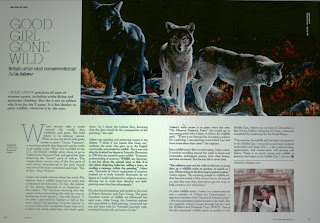
Good girl gone wild
British artist and conservationist Julie Askew
By Ana Maria Luca - Beyond Magazine, Beirut, Lebanon
–
Julie Askew practices all sorts of extreme sports, including scuba diving and mountain climbing. But she is not an athlete who lives for the X game. It is her destiny to paint wildlife, wherever it is, she says.When tourists take a cruise around the world, they sunbathe and party. But Julie Askew is no ordinary tourist. When at sea, she dived with green turtles to paint “Ocean Treasure”, a touching artwork that depicted a green turtle in an empty ocean. When she travelled to the U.S., the British wildlife artist chose to go to Yellowstone National Park and spend her time observing the “Lamar” pack of wolves. The conservation success story of the first pack of wild wolves reintroduced in the park turned into one of her most acclaimed paintings: “Eye to Eye – Gray Wolves”.
Askew can speak volumes about her work. She believes that a wildlife artist has to study and understand environment. To her, the habitat of the species depicted is as important as the subject. “For instance, ensuring that the season of the surroundings fits with the coat or feathering of the species,” she tells Beyond
. “I am often captivated by habitat as well as the main subject. My painting “Autumn Leaves” is as much about the wonderful Aspen trees as it is about the white tailed deer who feeds upon them. So I chose the habitat first, knowing that the deer would fit the composition of the painting,” she said.Askew says painting and preserving nature is her destiny. “I think it was nature that chose me,”confesses the artist, who grew up in the English countryside, surrounded by wildlife. But it was only after she finished her degree in Scientific Illustration in 1993 that she started to paint wildlife. “
It requires understanding of anatomy. Wildlife art, however, is not just about the animal, bird, or fish. It is also about depicting behavior, telling a story, or sending a message within the painting,” Askew says. “Leonardo da Vinci’s exploration of anatomy inspired me to study scientific illustration for my degree so I could understand my subject’s anatomy, allowing me to work from sketches and fieldpainting more than from photographs.”
She also found inspiration and models in the work of Robert Bateman and Paco Young. The great Canadian master of wildlife art influenced her early years, while Young, the American painter who specialized in field-painting, conquered her eye and heart with his “beautiful painterly style, wonderful brushwork, and sense of color”.
Askew’s main secret is to paint what she sees. “Go. Observe. Preserve. Paint!” she would say to any young artist who is keen to follow the wildlife path. “There is no formula for choosing a subject for a painting. I see paintings everywhere I go and have more ideas than time!” she explains.
But a wildlife artist’s life is not the easiest, Askew warns. It involves travelling around the world to locate and immortalize endangered species, show their beauty, and raise awareness. But she says she is never tired. “My subjects may not be with us forever; it is my duty as a wildlife artist to portray as much as I can. Observation is the first step to preservation,” Askew argues. “By exposing people to wildlife art, they become aware of the nature that is all around us, and they may then themselves get the wish to help conserve our wild places.”
As most wildlife artists, Askew is a conservationist and a member of “Artists for Conservation”,a signature member of the “Society of Animal Artists”– the most prestigious global society in the field. She also supports variuous causes through her art, such the Wildfowl and WetlandsTrust (WWT).
One of the first renowned wildlife artists to exhibit in the Middle East, Askew was on show in December at Bait Muzna Gallery, Sultanate of Oman, where she has completed four paintings for the Royal Palace.
“The reaction [to wildlife art] has been very positive in the Middle East. I see good conservation projects undertaken and hope that [...] the understanding, appreciation, and conservation will develop and thrive.
There is so much nature and wildlife to preserve and enjoy in the Middle East,” she says.
Words ANA MARI A LUCA,
Photos JULIE ASKEW

